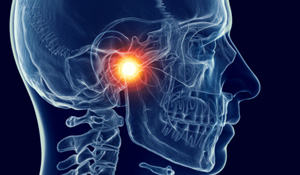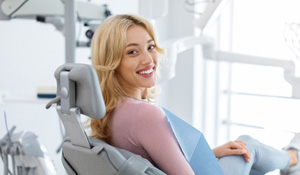TMJ Treatment Wichita Falls
Solutions for Chronic Jaw Pain and Headaches
 Your temporomandibular joints, or TMJs for short, are what allow you to make the necessary jaw movements for chewing food or speaking. However, if the TMJs become injured or are overworked, it can lead to serious problems. If you suspect that you have a TMJ disorder, we encourage you to call our office today. Once our team has taken a closer look at your jaw and learned more about your situation, Dr. Strohman can create a treatment plan that can put you on the path toward relief from your discomfort.
Your temporomandibular joints, or TMJs for short, are what allow you to make the necessary jaw movements for chewing food or speaking. However, if the TMJs become injured or are overworked, it can lead to serious problems. If you suspect that you have a TMJ disorder, we encourage you to call our office today. Once our team has taken a closer look at your jaw and learned more about your situation, Dr. Strohman can create a treatment plan that can put you on the path toward relief from your discomfort.
Why Choose Strohman Dental for TMJ Treatment?
- Gentle, Personalized Occlusal Adjustments
- Comfortable, Durable Occlusal Splints
- Caring, Knowledgeable Dental Expert
 What is TMJ Disorder?
What is TMJ Disorder?
A TMJ disorder is when one or both TMJs are damaged or strained. This can happen for a variety of reasons; sometimes it may be a consequence of getting hit in the jaw, but it may also be the result of repeated grinding and clenching of the teeth. At its most severe, TMJ disorder can significantly decrease your overall quality of life, and it can easily get worse if it is not treated appropriately.
 Symptoms of TMJ Disorder
Symptoms of TMJ Disorder
You might have a TMJ disorder if you’re experiencing any of the following symptoms:
- There is pain in your jaw that won’t go away.
- Your jaw occasionally becomes locked in an open or closed position.
- You hear a clicking or popping sound whenever you move your jaw.
- You are experiencing earaches and sometimes hear a ringing sound.
- You have noticed a change in your bite.
- You have started to find it difficult to chew your food.
- You are suffering headaches or pain behind your eyes.
A TMJ disorder isn’t necessarily the only explanation for these symptoms, but it’s certainly a possibility that you should keep in mind. If you pay our team a visit, we can help you determine whether a TMJ disorder is present.
 Types of TMJ Treatment
Types of TMJ Treatment
Our team will capture X-rays of your mouth and jaw in order to get a full picture of the situation. The more information we gather, the easier it will be to devise an appropriate treatment strategy. Below are some of the services that we provide that can help relieve the pain in your jaw.
Occlusal Splint

An occlusal splint can help the lower jaw find a more comfortable resting position so that it doesn’t put as much pressure on the TMJs. On top of that, it keeps the upper and lower rows of teeth separate in order to provide protection against clenching and grinding. This ultimately gives the TMJs a chance to rest and recover.
Equilibration/Occlusal Adjustment

A problem with your bite can expose your TMJs to unnecessary pressure. However, this type of issue can often be corrected with an occlusal adjustment, which involves removing small amounts of enamel from specific teeth. This helps ensure that the upper and lower rows of teeth come together as they should, resulting in a more balanced bite that allows the jaw joints to relax.
TMJ Treatment FAQs
How Is TMJ Disorder Diagnosed?
TMJ disorder isn’t always easy to diagnose; keep in mind that it often causes symptoms, like mouth pain, that happen to overlap with other common conditions. That said, a qualified dentist is capable of recognizing the issue, and they’ll normally ask questions about your symptoms and medical history to gain a clearer understanding of your oral anatomy. They’ll also check the positioning of your teeth, ask you to perform certain jaw movements, and look for signs of inflammation. In some cases, X-rays or CBCT scans may be needed to discover any issues affecting the jaw joints or nearby muscles.
Can TMJ Disorder Be Cured Permanently?
The discomfort that’s associated with TMJ disorder (TMD) can sometimes subside on its own over time, but this isn’t a common occurrence—and if your symptoms are starting to impact your everyday life and causing jaw pain or difficulty moving your mouth, it’s probably time for you to schedule professional treatment. Some TMJ treatment methods provide temporary relief, while others, such as occlusal splints and occlusal adjustments (sometimes called equilibration), are designed to permanently address issues like jaw tension, misalignment, or underlying TMD causes. Since the jaw joints are so complex in nature, it’s also important to note that routine visits allow us to keep an eye on things and ensure no harmful symptoms return.
Is TMJ Treatment Safe?
When performed by a qualified dental professional, TMJ treatment is completely safe and will not lead to negative or lasting ill effects. In fact, the first approach taken when it comes to TMJ treatment is often one that’s as minimally invasive as possible using conservative methods—surgery is only ever suggested as a very last option if nothing else is successful. Occlusal splints and occlusal adjustments have been proven as two of the most overwhelmingly safe TMJ treatment solutions out there. You should also remember that attempting to treat your TMJ disorder yourself using a method that isn’t backed up by medical science might cause your pain to worsen, or it could lead to other problematic symptoms. Contact our team for help instead!
How Long Does TMJ Treatment Take?
While some at-home jaw exercises can provide immediate (yet still temporary) relief, long-term relief generally requires a commitment to professional treatment. The timeline depends on the specific treatments needed, which can vary based on the cause and severity of the disorder. For example, occlusal splints are typically worn every night for a few weeks to several months before symptoms are alleviated—and the relief has the potential to last a lifetime. Equilibration/occlusal adjustments can vary in how quickly they bring relief, depending on the specific changes that need to be made. However, once the teeth and jaw have been realigned, relief follows almost immediately.